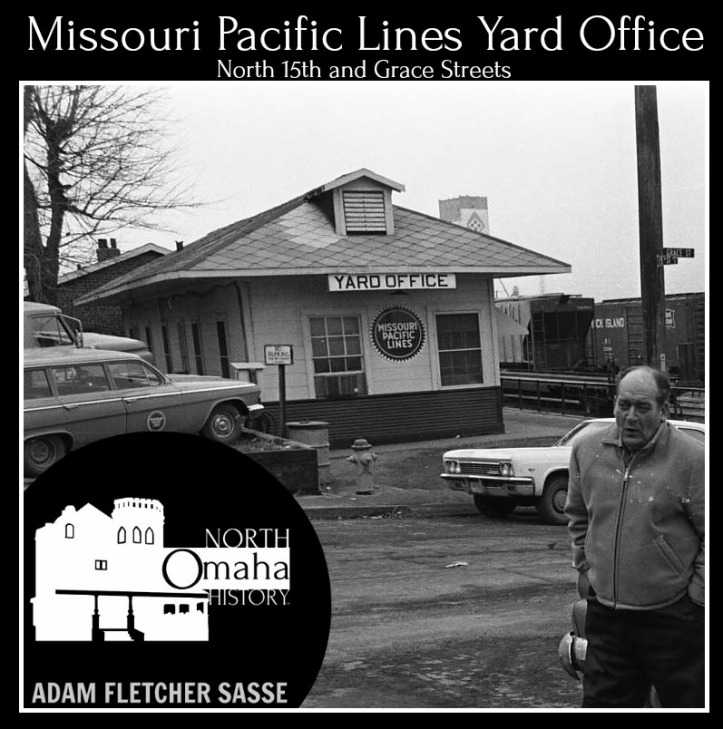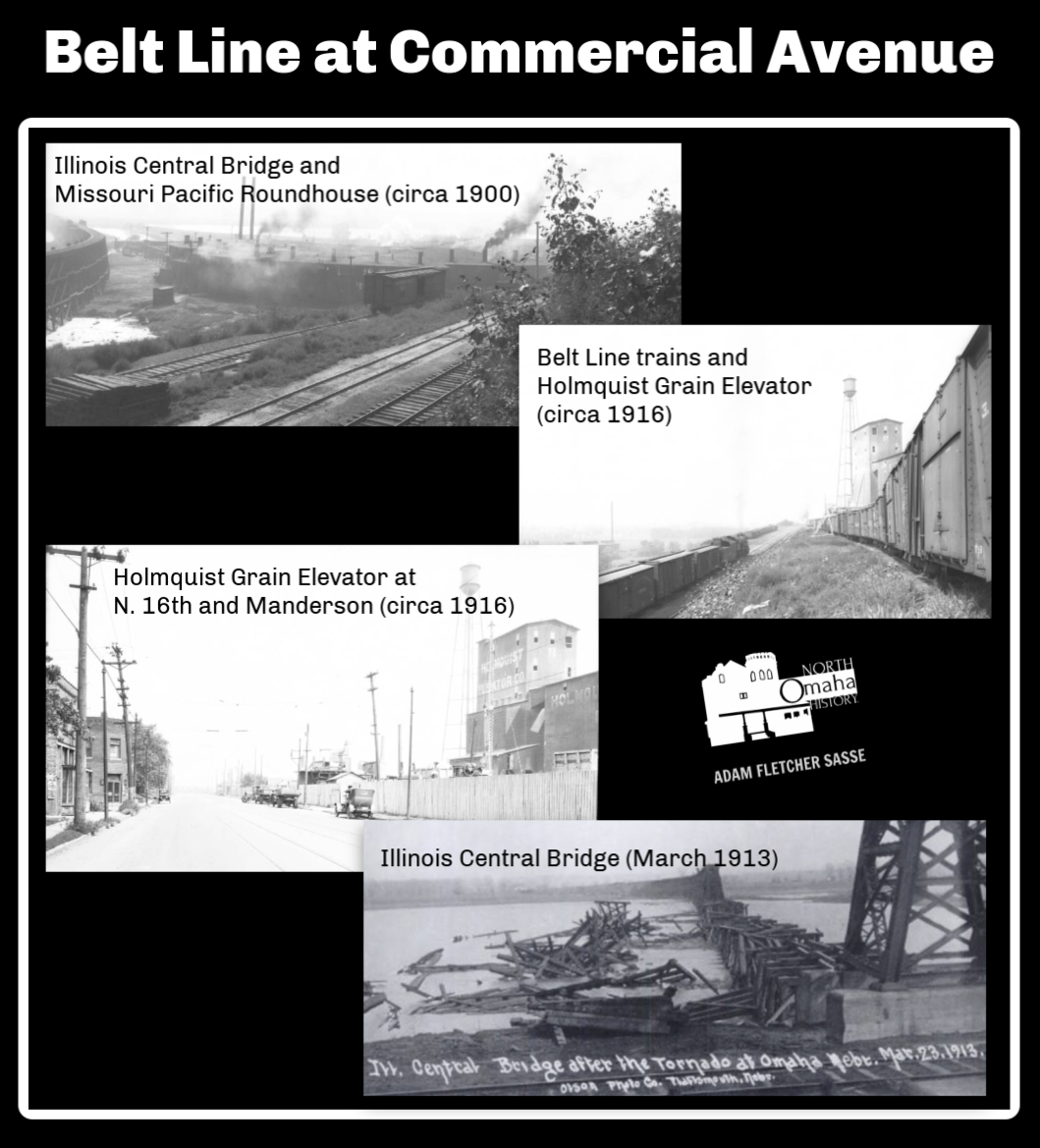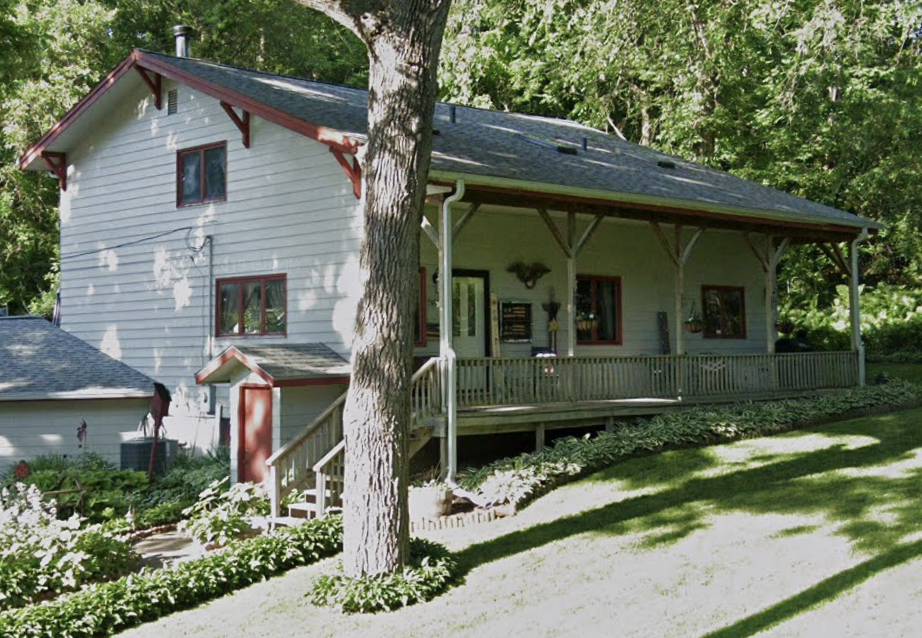Tracks, trestles, bridges, roundhouses, switching yards, maintenance shops and more left indelible marks throughout North Omaha. The Missouri Pacific, Omaha Road, Union Pacific and several other companies haunted the community. However, today, there’s nothing left aside from a few tracks, empty rail beds and a couple decaying bridges and trestles. Over the last 150 years there were five different railroad companies, a dozen depots, eleven bridges and trestles, two roundhouses and much, much more railroad infrastructure used to be scattered across North Omaha. This article is a lowdown of the history of railroads in North Omaha. Share your stories in the comments section that follows, please.
Missouri Pacific Railroad in North Omaha
Originally started by the Missouri Pacific, or MoPac, Railroad, the Belt Line railway was once a passenger service, then an industrial line for 75+ years. Today, there’s nothing left of it besides an empty rail bed.

Of all the railroad-related history in Omaha, there are two things that excite me most. The first are the labor struggles in the industry, and the second is the Belt Line Railway owned by the Missouri Pacific Railroad. After starting at a station downtown at N. 15th and Webster, it went north along the bottom of the bluffs east of N. 14th to Locust Street, then crossing N. 16th on a trestle at Commercial Ave. Then it crossed Commercial before Ames Avenue, going between Taylor Ave and Ames (along a street called Boyd that doesn’t exist there anymore). There was originally a depot at 4351 N 22nd St along this section. Then, the Belt Line shot west and across 30th to a depot at 32nd and John Creighton Blvd, then to a depot at 40th and Lake, then a depot at 43rd and Nicholas, then a depot at Military and Hamilton, then south over Dodge and beyond.
Chicago and Northwestern Railroad in North Omaha

The railroad heading up the modern-day Sorensen Parkway was the Fremont, Elkhorn & Missouri Valley Railroad, which was bought by the Chicago and Northwestern Railroad. Starting downtown, the railroad travelled through the North Omaha Yards to Locust Street, eventually going west through the ravine now used by the Storz Expressway to North 30th, which it cross with a trestle. It then went to a station by Fort Omaha and onward to Debolt, Bennington, Irvington, Fremont and beyond.
The Omaha Road in North Omaha
Another railroad headed north from the Webster Street Station north to Florence and points beyond. It was the Chicago, St. Paul, Minneapolis and Omaha Railway, aka the Omaha Road.

After coming north along the bluffs, it went to a roundhouse north of Locust and west of Carter Lake Drive. It then went north to a trestle over Minne Lusa Boulevard and past the Minne Lusa Water Works, then to the Florence Depot at North 28th and Tucker. After that, it went to Briggs, Nashville, Blair and beyond.
Illinois Central Railroad in North Omaha

The Illinois Central Railroad crossed the Missouri River at East Omaha. Its more than 500 feet long, and was the longest swing bridge in the world from when it was completed in 1915. The IC then came east to a roundhouse at in old Sulphur Springs by North 13th and Wirt Streets. That roundhouse was demolished, and the railroad from East Omaha to North 13th was removed.
With the impact of the IC and other companies following its lead, by the 1920s, East Omaha was packed full of railroads. In addition to the bridge and the roundhouse, the IC had a terminus in East Omaha and maintenance yards at North 13th Street north of Locust.

The Omaha Road had a roundhouse and small railyards there, too, along with the UPRR line that ran to factories on the north side of Carter Lake. The IC spurs to the East Omaha Factory District was busy, and railcars constantly hauled ice from massive icehouses on the lake as late as the 1930s. While almost all of that infrastructure is gone today, its easy to imagine how busy the area was.
Today, the Canadian National Railway owns the East Omaha bridge, it is closed and locked open, and is poorly maintained.
Union Pacific Railroad in North Omaha

I’d be remiss to neglect the Union Pacific Railroad’s role in the history of North Omaha. They had no trunk line or bridge that spanned any part of North Omaha. They didn’t build a shiny station to benefit the community, or pour tons of money directly into the area.
Instead, north of Dodge Street they had a single line that wrapped around the north side of Carter Lake. And a massive rail yard north of Cuming Street beside North 11th Street, and their massive shops near at North 9th and Cuming Streets.
The Union Pacific Railroad also employed many North Omahans. From the early years of the railroad through the 1960s, African Americans were hired almost exclusively to work as cooks, waiters, and porters for the railroad. Other Blacks were hired by the Union Pacific as strikebreakers, and many migrated to Omaha from The South for these jobs in the late 1870s. Despite being paid menial wages and struggling to stay employed, by the 20th century a growing number of African American employees of the Union Pacific managed to maintain a middle class lifestyle in the Near North Side.
As the veil of white supremacy and workplace racism began lifting in the 1960s, African Americans achieved higher roles in the company. Eventually, some became stewards, inspectors and engineers for U.P. Today, there are Black managers throughout the company in Omaha and beyond.
However, when the working class Union Pacific jobs left Omaha en masse in the 1960s, North Omaha was adversely affected too. With remarkably fewer employment opportunities, youth found themselves without visions for the future and the immediate prospect of relieving tension and forcing attention to their situation led to rioting and protests in the community. Along with industries like the packinghouses and stockyards, and poor city leadership, the Union Pacific, along with the smaller rail lines in the city, was responsible for this.
Today, the heritage of African Americans working for the Union Pacific is celebrated at their museum in Council Bluffs, and by the Union Pacific Railroad’s Black Employee Network, or BEN. BEN began in Omaha in 1979 with five employees, with more than 700 today. There are BEN chapters in St. Louis, North Little Rock, Kansas City, Memphis, Los Angeles, Fort Worth, Houston, Omaha, Chicago and Addis, Louisiana. The mission of BEN is to increase the recruitment, retention and advancement of African-American employees within Union Pacific, by promoting and facilitating personal and professional growth, and working with UP senior leadership on diversity issues. BEN also provides scholarships, encourages post-secondary education for high school graduates, and supports local African-American communities.
Depots and Stations in North Omaha
I’ve found at least nine stations in North O affiliated with various railroads. The Belt Line Railway began as a passenger transport, and required depots for pickup and drop off. They included the Webster Street station, the Oak Chatham depot, the Druid Hill depot, the Lake Street depot, the Nicholas Street depot and the Walnut Hill depot.

There were several other railroad depots in North Omaha, too. The Omaha Road had two stations in North Omaha, including the Florence Depot and the Briggs Station. Located near McKinley Drive, Briggs Station was built around 1887 and abandoned by the early 1920s. The Briggs Station still exists and has been repurposed as a house on the old Washington Highway in the Ponca Hills.
The Omaha Heights Station was located near North 42nd and Hartman Avenue on the Fremont, Elkhorn and Missouri Valley Railroad between 1883 and at least 1917. Once the location of a large paint factory, this station was popular for several years.
After leaving north from downtown, the CNW used the Omaha View depot and the DeBolt station.
By 1876, there was also a separate stop for the Fremont, Elkhorn & Missouri Valley Railroad (later the Chicago and Northwestern Railroad) to serve Fort Omaha called the Briggs Depot. Located at 3190 Grand Avenue, it served the area for almost forty years until a grand crash demolished the building.
Other Railroad Infrastructure in North Omaha

Its challenging to account for all the railroad infrastructure in North Omaha, if only because there was so much of it. By far the largest place was called the North Yards. It was a massive area of rails, shops and other industry-related places that was located north of the Union Pacific shops, extending roughly from Cuming to Locust Street, from North 9th to North 14th Street.
There were trestles over Cuming around North 40th; over North 30th at Hartman; over Minne Lusa Boulevard near JJ Pershing Drive; and over North 16th Street at Commercial Avenue. There was also a large a viaduct on Locust from North 11th to North 16th, and another over Nicholas from North 13th to North 16th Street.
There were two roundhouses north of Locust Street and east of North 14th. One was operated by the Missouri Pacific, and the other was for the Omaha Road. There were also at two train bridges across the west arm of Carter Lake operated by the Illinois Central Railroad.

North Omaha Railroad Tour
Much the same as railroad infrastructure across the United States, North Omaha’s depots, stations, trestles, bridges, roundhouses and rails themselves have largely faded from the community’s landscape. However, their places don’t have to be lost! Here’s a list of railroad places in North Omaha.

- North Yard, N. 11th and Nicholas St (demolished)
- Missouri Pacific Freight Depot, N. 14th and Webster St (demolished)
- Webster Street Station, 1490 Mike Fahey St (demolished)
- Oak Chatham Depot, 4351 N. 22nd St (demolished)
- Druid Hill Depot, 4230 N. 30th St (demolished)
- Lake Street Depot, 2480 N. 40th St (demolished)
- Nicholas Street Depot, 4360 Nicholas St (demolished)
- Walnut Hill Depot, 4242 Hamilton St (demolished)
- Florence Depot, 2800 Tucker St (standing)
- Briggs Depot, 3190 Grand Ave (demolished)
- Briggs Station, 5300 Sargent St (demolished)
- Omaha View Depot, 3200 Grand Ave (demolished)
- DeBolt Station, 7000 N. 60th St (demolished)
- Omaha Road Roundhouse, 35 Carter Lake Shore Dr (demolished)
- Missouri Pacific Roundhouse, 35 Carter Lake Shore Dr (demolished)
- Illinois Central Bridge, 41°16’44.4″N 95°53’31.8″W (standing)
- Missouri Pacific Trestle, 4448 Cuming St (demolished)
- Missouri Pacific Railroad Yard Office, N. 15th and Grace Street (demolished)
- Chicago and Northwestern Trestle, 4900 N. 30th (demolished)
- OPPD Trestle, 41°19’39.1″N 95°56’25.6″W Minne Lusa
- Omaha Road Trestle, 41°19’37.2″N 95°56’58.4″W Minne Lusa (standing)
- Missouri Pacific Trestle, 4140 N. 16th (demolished)
- Union Pacific Bridge, 4405 Carter Lake Shore Dr. W (demolished)
- Locust Street Bridge, 1415 Locust St (demolished)
- Locust Street Viaduct, 1415 Locust St (demolished)
- Nicholas Street Viaduct, 1450 Nicholas St (demolished)
- Missouri Pacific Carter Lake Bridge, 35 Carter Lake Shore Dr (demolished)
- Omaha Heights Station, 3701 North 42nd St (demolished)
Other railroad-related places included the Railroad Men’s Benevolent and Social Club at North 24th and Miami Streets in the 1950s; and the Waiters and Porters Headquarters was located in today’s Blue Lion Center at 2421 North 24th Street from the 1930s into the 1950s. The Sleeping Car Porters Headquarters was located at North 27th and Lake in the 1920s and 1930s, but I haven’t figured out where at that intersection yet.
You Might Like…
- A History of the Belt Line in North Omaha
- A History of the Village of DeBolt, Nebraska
- A History of Squatter’s Row
MY ARTICLES ABOUT THE BELT LINE RAILWAY IN NORTH OMAHA
Businesses:4402 Florence Blvd | 4426 Florence Blvd | 4225 Florence Blvd | Omaha Casket Company | U.S. Brush Company | Murphy, Wasey and Company Factory | Iten-Barmettler Biscuit Company | Uncle Sam Breakfast Food Company | Storz Brewery | Douglas Motors Corporation
Neighborhoods: Nicholas Street Historic District | Squatter’s Row | Near North Side | North Omaha Bottoms | Sulphur Springs | Saratoga | Bedford Place | Plum Nelly | Clifton Hill | Orchard Hill | Walnut Hill | Military Avenue
Related: Railroads | 30th and Ames | 16th and Locust | 40th and Hamilton
Elsewhere Online
- “Supporting Diversity” on the official Union Pacific Railroad website
BONUS PICS!
















Leave a comment